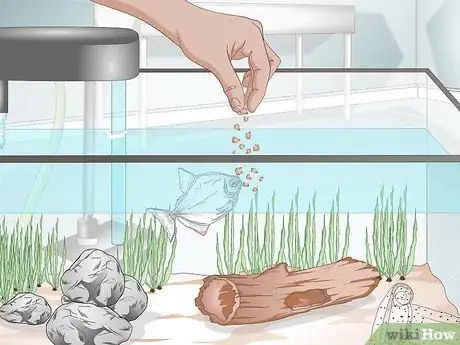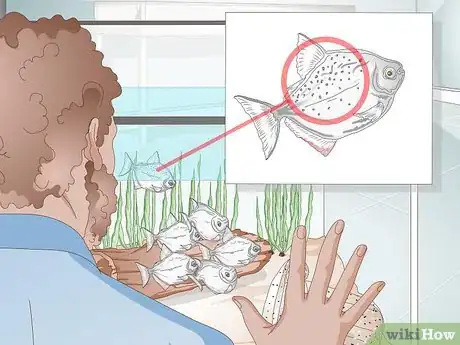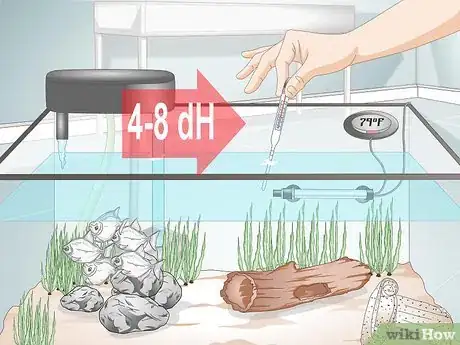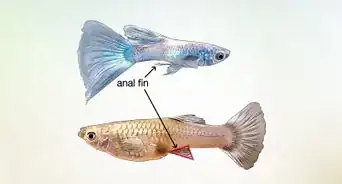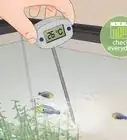This article was co-authored by Pippa Elliott, MRCVS. Dr. Elliott, BVMS, MRCVS is a veterinarian with over 30 years of experience in veterinary surgery and companion animal practice. She graduated from the University of Glasgow in 1987 with a degree in veterinary medicine and surgery. She has worked at the same animal clinic in her hometown for over 20 years.
There are 14 references cited in this article, which can be found at the bottom of the page.
wikiHow marks an article as reader-approved once it receives enough positive feedback. In this case, 91% of readers who voted found the article helpful, earning it our reader-approved status.
This article has been viewed 185,658 times.
The silver dollar fish is an herbivorous fish belonging to the Characidae family that is native to South American freshwater rivers.[1] These fish are frequently selected for aquariums because they are visually appealing and easy to care for. Learning how to feed and house your silver dollar fish will help improve the chances that it will live a long and healthy life in your home aquarium.
Steps
Raising Silver Dollar Fish
-
1Choose the right tank size. One of the biggest factors in a fish's survival and wellbeing is the environment it lives in. Housing your silver dollar fish in a small, cramped tank can be very uncomfortable for your pet, and if you have more than one fish in the tank they may begin to compete for resources.
- Some breeders recommend having a tank that holds at least 50 gallons of water to ensure adequate space.[2]
- If you're considering housing a school of fish or breeding your own silver dollar fish you will need an even larger tank.
-
2Decide whether to provide aquatic plants. Silver dollar fish tend to uproot and eat live aquarium plants, which may deter some aquarium enthusiasts from providing plants.[3] However, having plants (even if they're artificial) is generally considered preferable.[4]
- Some aquarium enthusiasts add artificial plants to provide habitat for their fish without having to worry about the plants being eaten.
- If you decide to breed your silver dollar fish they will absolutely need plants, even if they're artificial. Silver dollar fish tend to lay their eggs on or around plants near the bottom of the tank.
Advertisement -
3Add hiding places to your tank. Fish may become frightened or overwhelmed from time to time, so it's important to provide them with places to escape from whatever has frightened them. This is particularly important if you plan on housing more than one fish in the same tank.[5]
- Rocks, flowerpots, driftwood, and plastic accessories are all considered acceptable hiding places to add to your home aquarium.
-
4Feed your fish a healthy diet. Silver dollar fish need a diet high in plants and vegetables. Commercial Spirulina-based foods and vegetable-based freeze-dried/flake foods are ideal. You can also feed your fish certain live foods, including brine shrimp, bloodworms, and glass worms.[6]
- Feed your fish pellets or flakes several times each day.[7] Watch your fish while it eats to gauge whether it's getting enough food and adjust accordingly.
- Some breeders choose to supplement their pets' diet with small chunks of vegetables, including zucchini and romaine lettuce leaves. However, these should be trimmed down to very small pieces so that the fish can easily eat and digest them.
-
5Give your fish playmates. Because silver dollar fish naturally swim in schools, it's best to keep your fish in a shared tank with other community tank fish (including other silver dollar fish). Just be sure any fish you add to the tank are known to be friendly and peaceful.[8]
- If you decide not to add other silver dollar fish, you may choose to add loricariidae, pimelodidae, South or Central American cichlids, pacu, arowana, or anostomus.[9]
- Having too many fish in the tank may cause territorial disputes or overcrowding.
- Groups of three to six schooling fish of a similar size are the ideal number for a given tank.
-
6Watch for health problems. All pets are at risk of illness, regardless of how well you care for them. Some fish breeds are more predisposed to health problems than others. Knowing what health problems silver dollar fish are prone to can help you keep an eye on your pet's wellbeing.[10]
- Silver dollar fish are particularly susceptible to a parasite called black spot/black ick.[11] You can treat this condition with aquarium salt available at pet stores.
- Because of their flat bodies, silver dollar fish are prone to constipation. This can be avoided by feeding a varied diet that includes fiber (vegetable matter).
- Many fish, including silver dollars, are susceptible to fungal infections. These can be easily treated at home with commercial products, which can be purchased at most pet stores.
Getting the Right Water Quality
-
1Regulate the water temperature. Because silver dollar fish tend to naturally inhabit waterways in South America, they typically thrive in slightly warmer water temperatures. Use a water heater and keep a thermometer in or near the tank so you can regulate the temperature as needed.[12]
- The ideal water temperature range for silver dollar fish is between 75 and 82 degrees Fahrenheit (23.9 to 27.8 degrees Celsius). However, they may be able to survive in temperatures as low as 71.6 degrees Fahrenheit (22 degrees Celsius).[13]
-
2Measure the pH. Percent hydrogen, or pH, is a measure of how acidic or basic a sample of water is. Some breeders recommend maintaining a pH between 6.0 and 7.5.[14] However, silver dollar fish can survive in water with a pH as low as 5.0 and as high as 7.8.[15]
- Check the pH every time you change the water. You may also want to test the pH of your water source to ensure that you're not introducing acidic or basic water to an otherwise stable environment.
- You can raise the pH by adding an alkaline buffer and lower it by adding an acid buffer.[16] Both products can be purchased at most pet stores or through an online retailer.
-
3
-
4Change the water in your tank. You should completely change the water at least once every month to ensure a stable habitat.[21] However, changing the water too frequently can deplete the bacteria your fish rely on. Because of this, it's recommended that fish owners perform partial water changes in which approximately 25% of the water is replaced. Partial changes can be performed about once every two weeks, though tanks that get dirty very quickly may need more frequent partial water changes.[22] You may not be able to use tap water for your aquarium, depending on the mineral and chemical composition of your water. Test your water at home before using it in your aquarium.
- Unplug any electrical devices, such as your heater and/or an overhead lamp.
- Scoop out your fish using a hand net and transfer them to a safe bucket or second tank while you clean. Then remove and clean the filter and any artificial plants or decorative accessories you may have submerged in your tank.
- Use a gravel cleaner to siphon out debris from the bottom of your tank. However, you should not use a gravel cleaner if your fish have recently laid eggs in the aquarium.
- Reverse osmosis water does not have any impurities, but it also lacks minerals that your fish may need.[23] If possible, use only deionized water for your fish tank.[24]
- Measure the temperature of your water and adjust the clean water's temperature accordingly before adding it to the aquarium. Then replace the items you removed and scoop your fish back into their primary tank.
Breeding Silver Dollar Fish
-
1Identify the sex of your fish. If you're interested in breeding silver dollar fish, you'll need to learn how to identify the males and females of the species so you can provide a suitable mate for your fish. Male silver dollar fish tend to have an anal fin that is longer than females. The anal fin is usually tinted red on most males as well.[25]
-
2Pair up males and females. Once you've identified the males and females of the species, you'll want to pair them up in equal proportions in your aquarium. However, it's generally best to add more than one fish to the tank and let the fish pair themselves up, rather than trying to mate a particular pair of fish.[26]
- Mix four to six fish with equal proportions of male to female (for example, if using four fish you would have two of each; if using six fish, have three of each). Let the fish decide how they want to pair up and don't interfere.
-
3Ensure there are plants in the tank. While some aquarium enthusiasts may be reluctant to provide silver dollar fish with aquatic plants, your fish will need some type of underwater plants during mating. These can even be artificial plants if you're worried about your fish eating the plants.[27]
- Silver dollar fish tend to lay their eggs on or around underwater plants.
-
4Exercise caution when cleaning the tank. If you're trying to breed your silver dollar fish, you'll need to ensure that you don't accidentally remove the eggs or hatched fry while cleaning your tank. Eggs hatch within about three days, and within a week the fry will begin to swim around inside the tank and attach themselves to the walls of the tank.[28]
- Try to hold off on cleaning the tank for a few days until the eggs are hatched and the fry are visible.
- Avoid using tank vacuums to clean your aquarium while there are eggs or fry present. Instead, try to do partial water changes and be sure you can see the fry at all times.
Things You'll Need
- Silver dollar fish
- Large fish tank
- A decent filter (ask someone who works at your local pet store for recommendations)
References
- ↑ http://www.aquariumlife.net/profiles/characidae/silver-dollar/100015.asp
- ↑ http://www.allabout-aquariumfish.com/2009/03/silver-dollar-tropical-fish.html
- ↑ http://www.allabout-aquariumfish.com/2009/03/silver-dollar-tropical-fish.html
- ↑ http://www.fishchannel.com/fish-species/freshwater-profiles/silver-dollar-2.aspx
- ↑ http://www.fishchannel.com/fish-species/freshwater-profiles/silver-dollar-2.aspx
- ↑ http://www.fishchannel.com/fish-species/freshwater-profiles/silver-dollar-2.aspx
- ↑ http://www.liveaquaria.com/product/prod_display.cfm?c=830+836+2522&pcatid=2522
- ↑ http://www.fishchannel.com/fish-species/freshwater-profiles/silver-dollar-2.aspx
- ↑ http://fish.mongabay.com/species/Metynnis_argenteus.html
- ↑ http://animal-world.com/encyclo/fresh/information/Diseases.htm
- ↑ http://animal-world.com/encyclo/fresh/information/Diseases.htm
- ↑ http://www.fishchannel.com/fish-species/freshwater-profiles/silver-dollar-2.aspx
- ↑ https://www.fws.gov/fisheries/ans/erss/uncertainrisk/Mylossoma-duriventris-WEB-7-11-14.pdf
- ↑ http://www.allabout-aquariumfish.com/2009/03/silver-dollar-tropical-fish.html
- ↑ https://www.fws.gov/fisheries/ans/erss/uncertainrisk/Mylossoma-duriventris-WEB-7-11-14.pdf
- ↑ http://www.drsfostersmith.com/pic/article.cfm?articleid=1320
- ↑ http://www.tropicalfishandaquariums.com/FishCare/dH.asp
- ↑ http://fish.mongabay.com/species/Metynnis_argenteus.html
- ↑ http://www.drsfostersmith.com/pic/article.cfm?articleid=1320
- ↑ http://www.liveaquaria.com/PIC/article.cfm?aid=60
- ↑ http://www.peteducation.com/article.cfm?c=16+2154&aid=2649
- ↑ https://users.cs.duke.edu/~narten/faq/water-changes.html
- ↑ http://www.drsfostersmith.com/pic/article.cfm?aid=842#answer_3
- ↑ http://www.drsfostersmith.com/pic/article.cfm?aid=842#answer_4
- ↑ http://www.fishchannel.com/fish-species/freshwater-profiles/silver-dollar-2.aspx
- ↑ http://www.fishchannel.com/fish-species/freshwater-profiles/silver-dollar-2.aspx
- ↑ http://www.aquariumlife.net/profiles/characidae/silver-dollar/100015.asp
- ↑ http://www.fishchannel.com/fish-species/freshwater-profiles/silver-dollar-2.aspx
About This Article
To care for a silver dollar fish, keep it in a 50-gallon tank to ensure adequate space. Add live aquatic plants and accessories like rocks or driftwood to create ample hiding places. Feed your fish a commercial Spirulina-based food or a vegetable-based flake food every day and occasionally provide live foods like brine shrimp and bloodworms as treats. It's also important to use a heater to maintain a water temperature of 75-82 degrees F. For tips on maintaining a healthy tank environment, read on!



